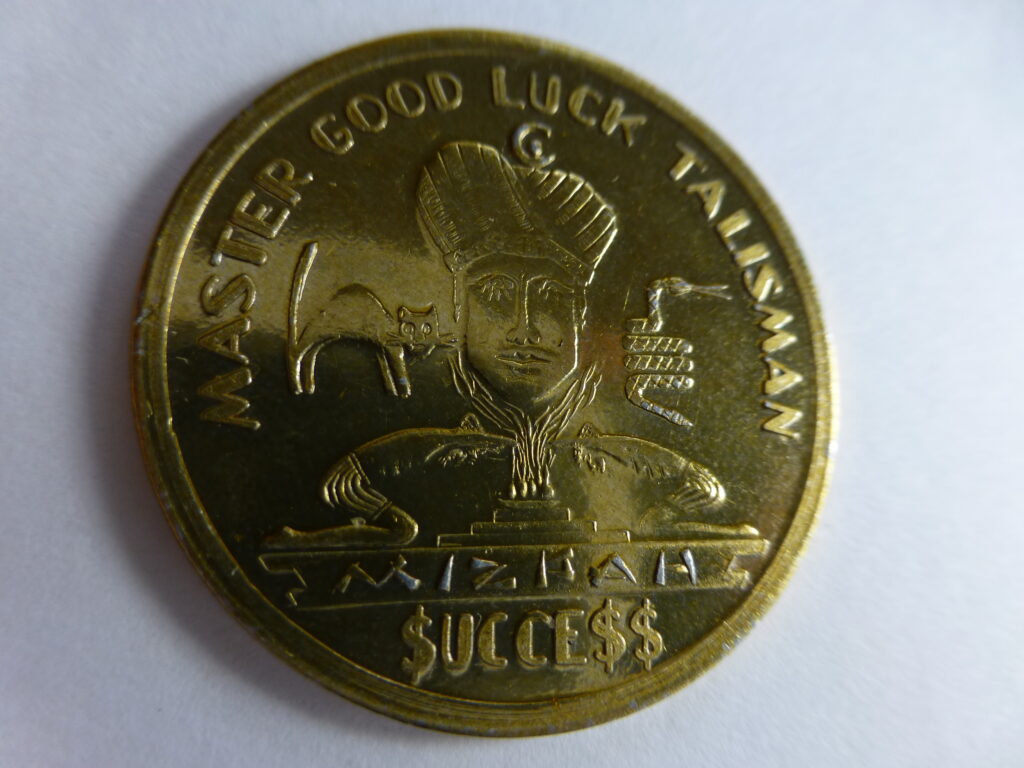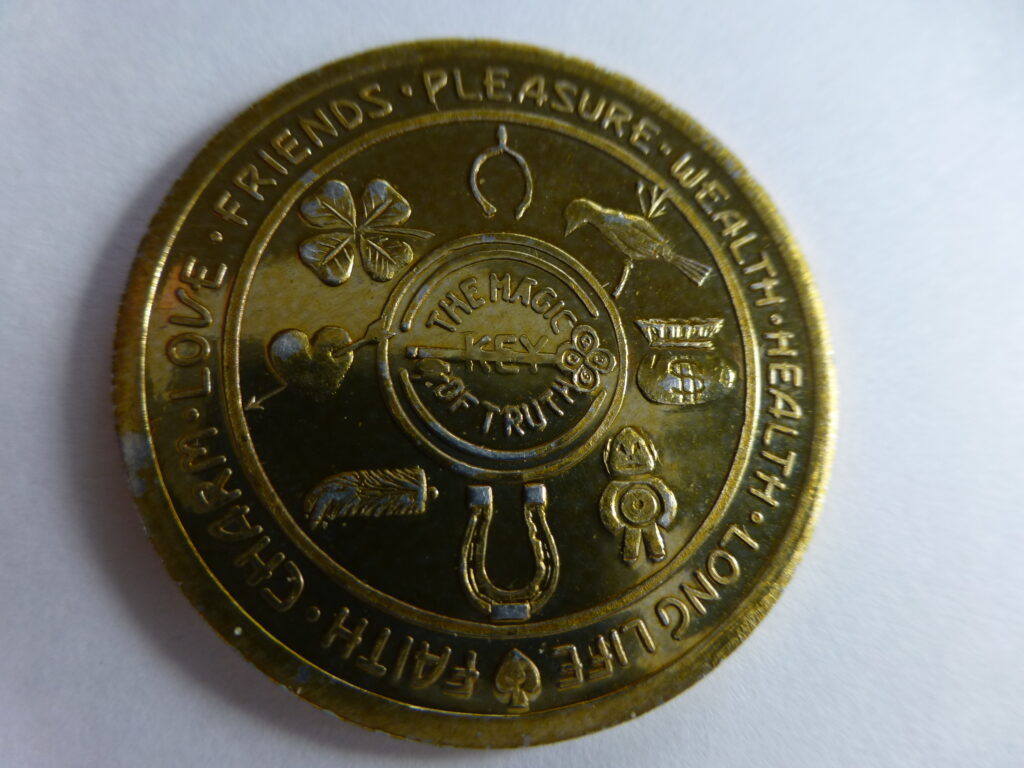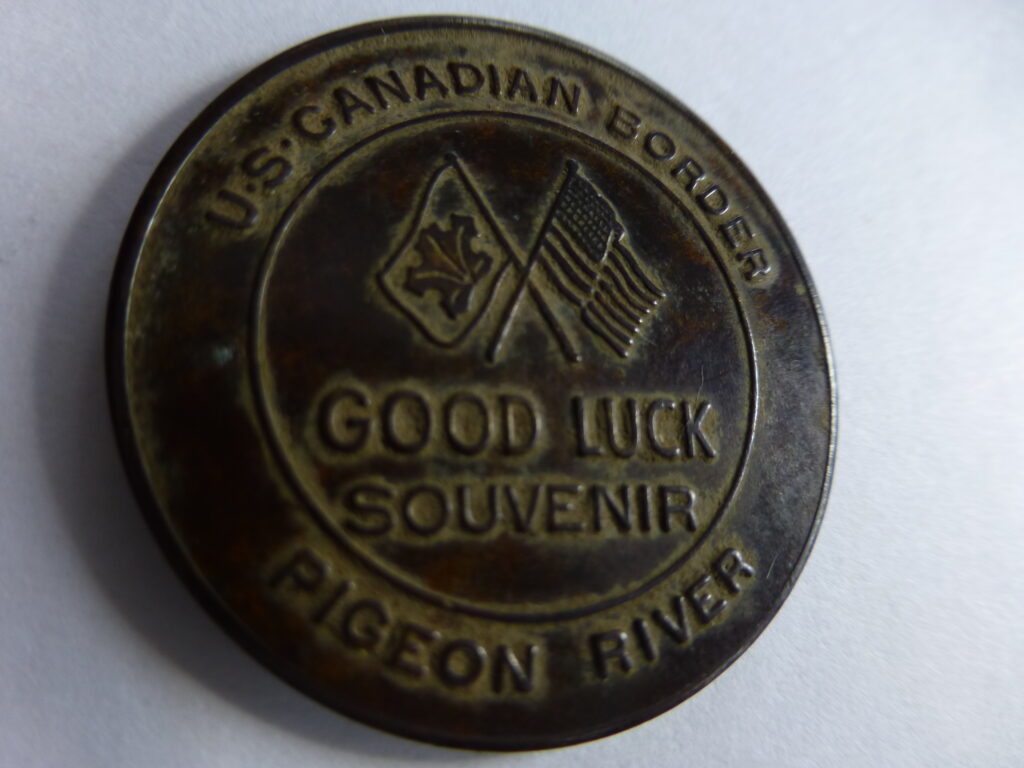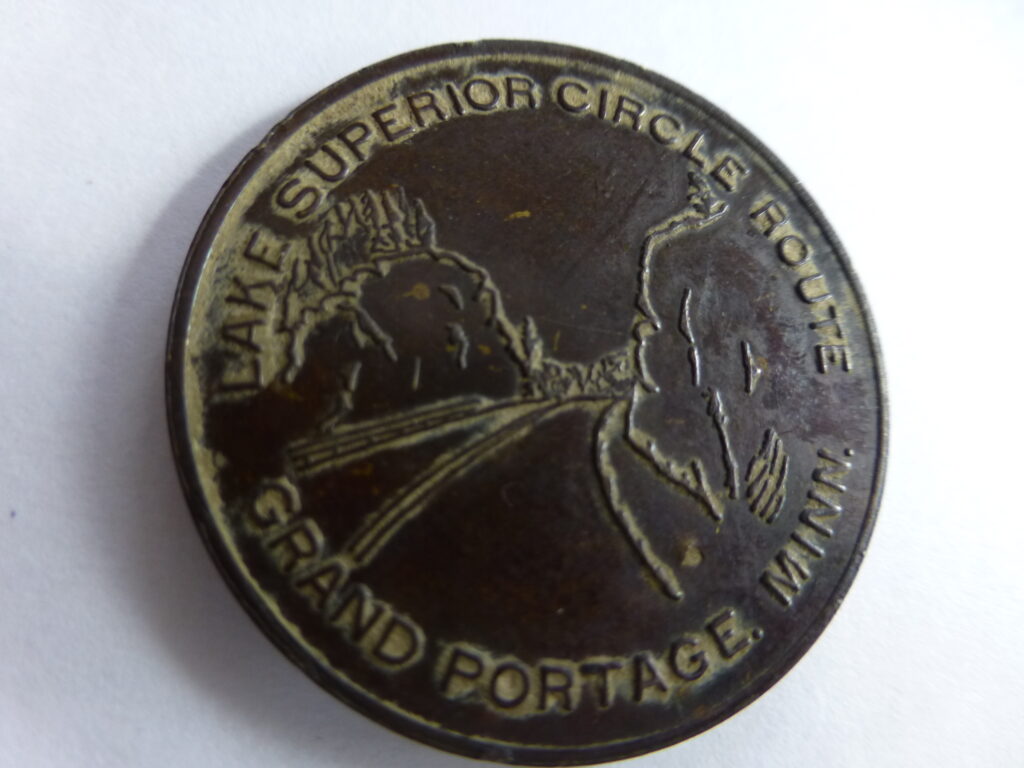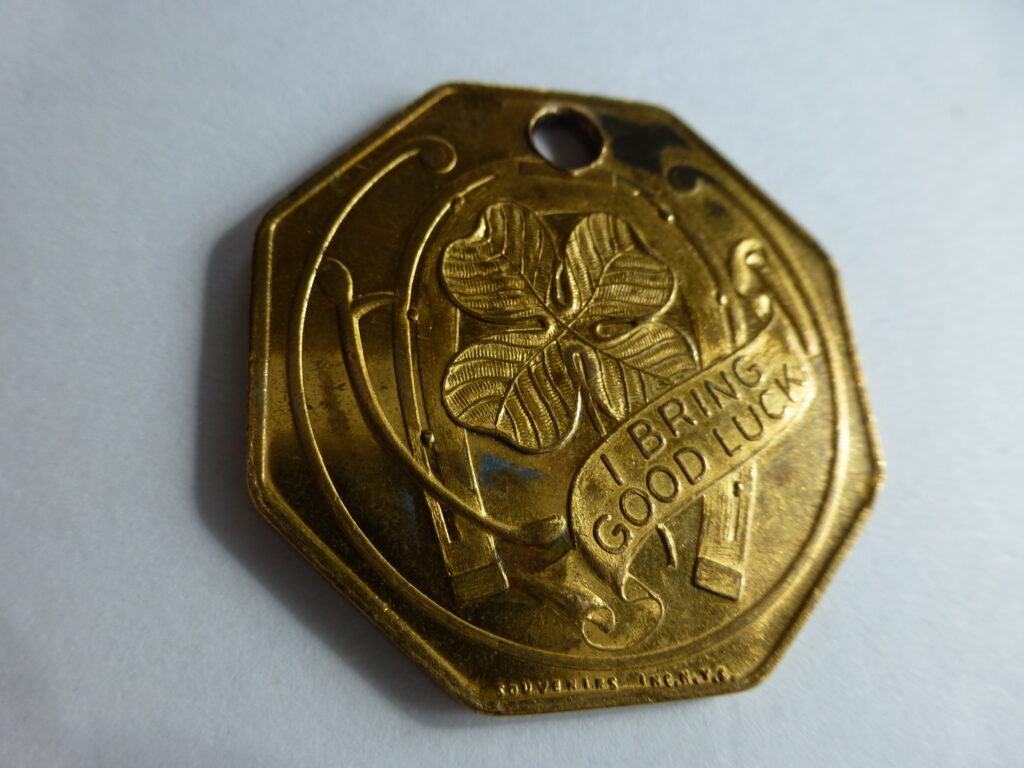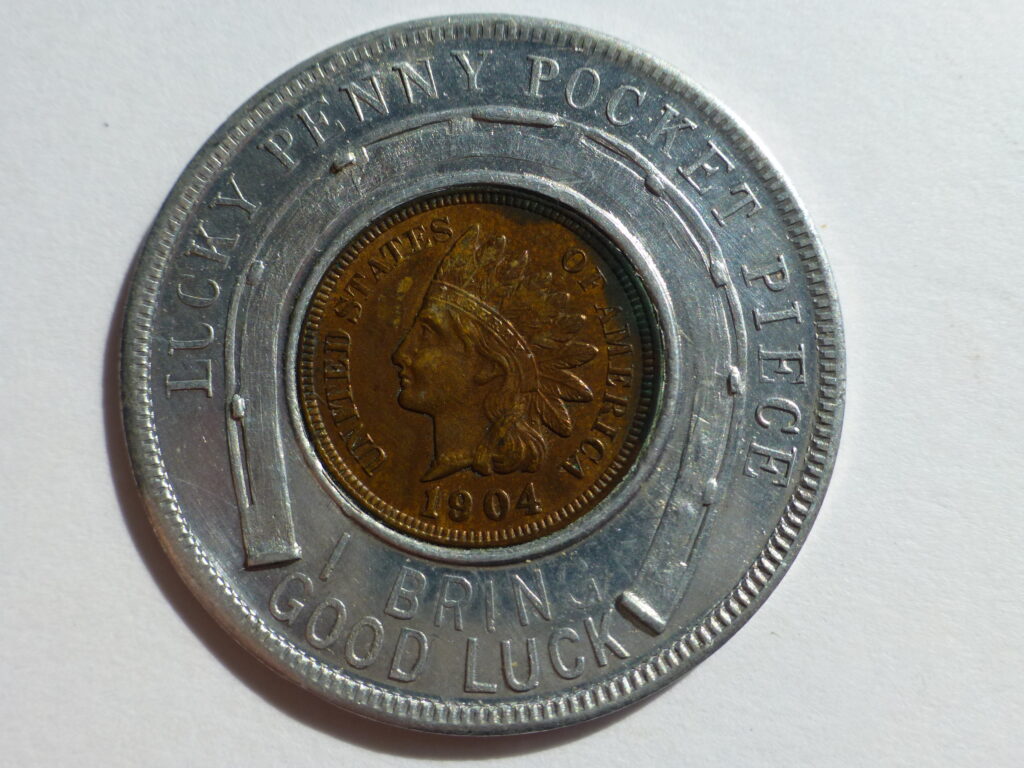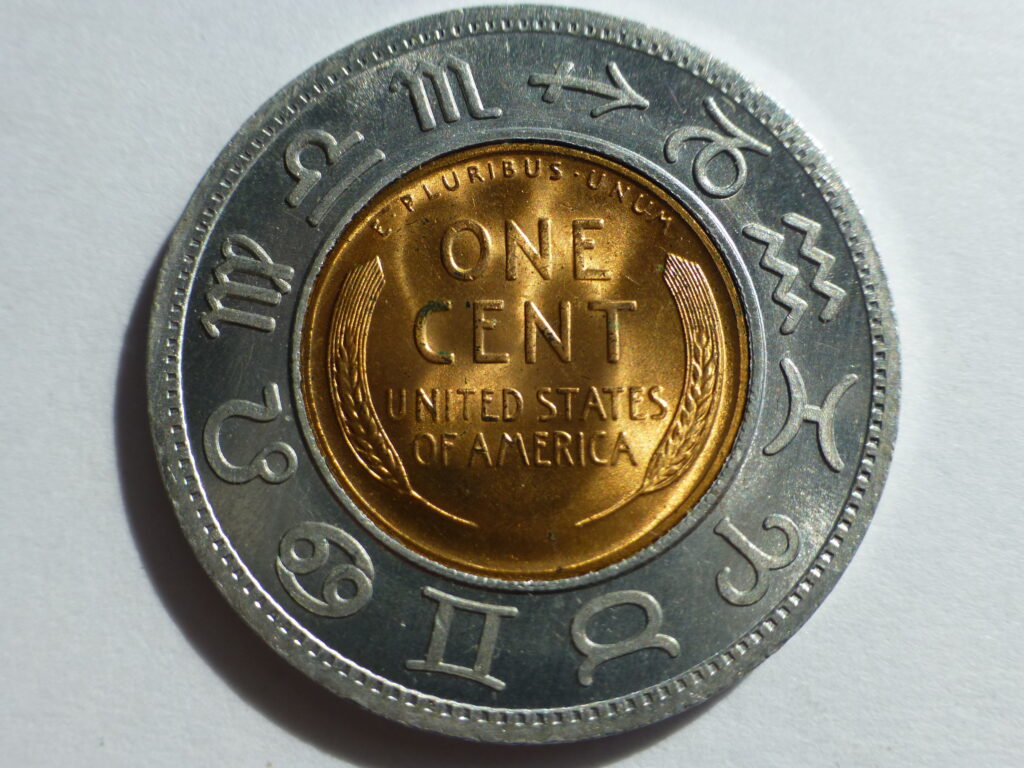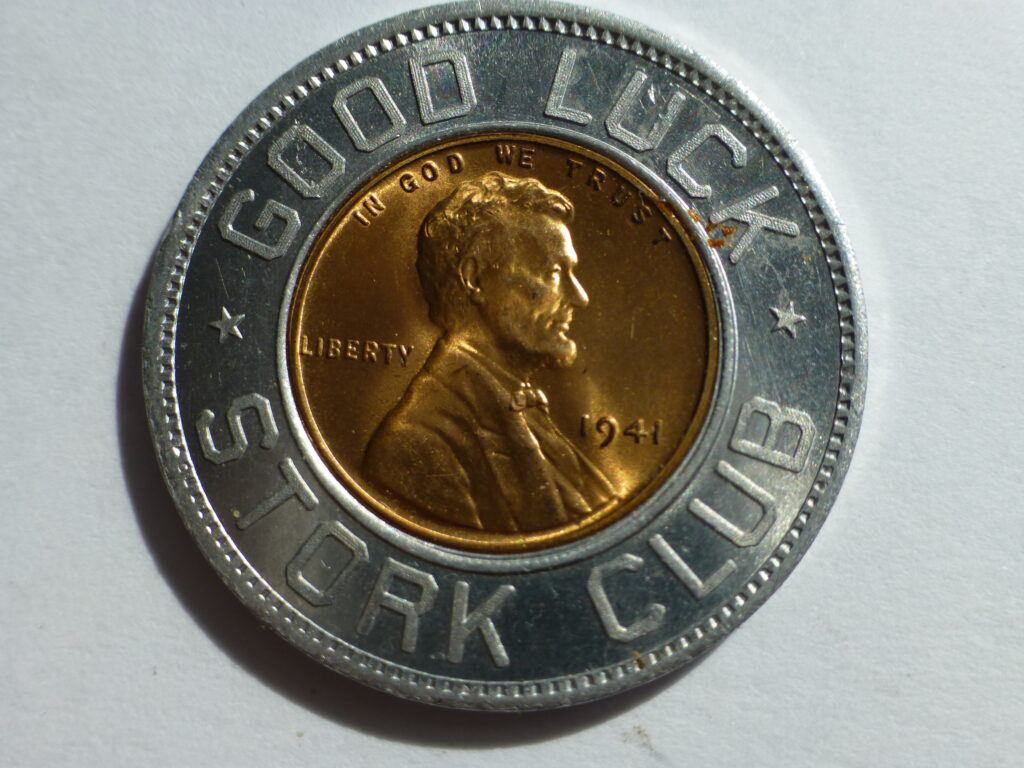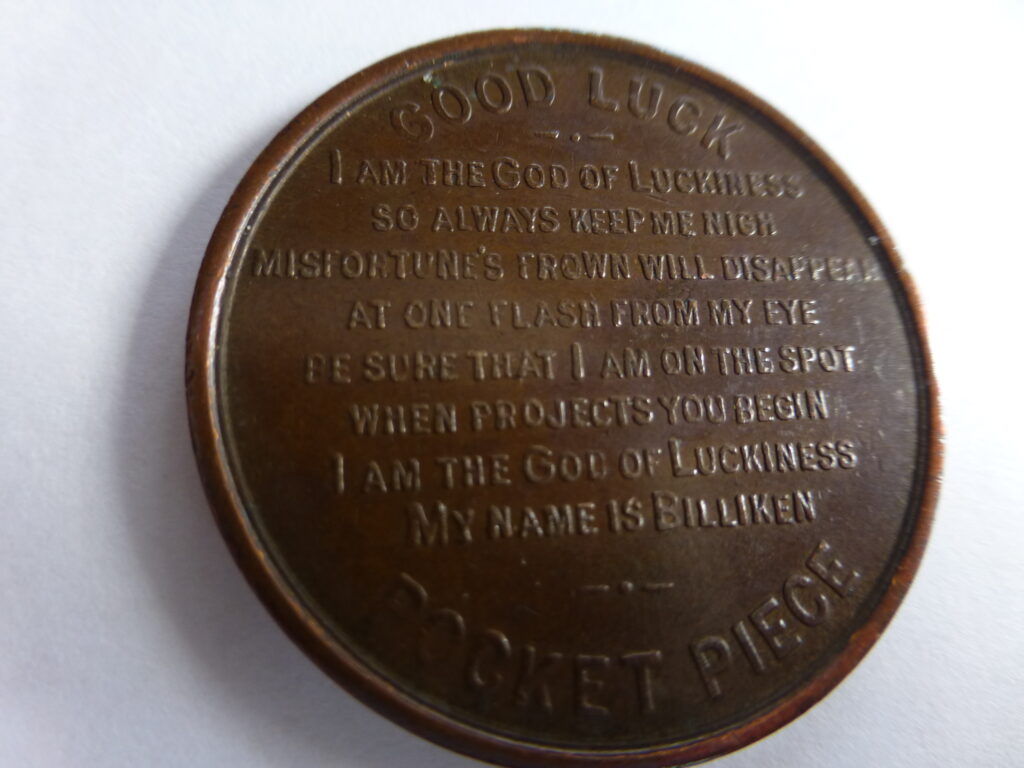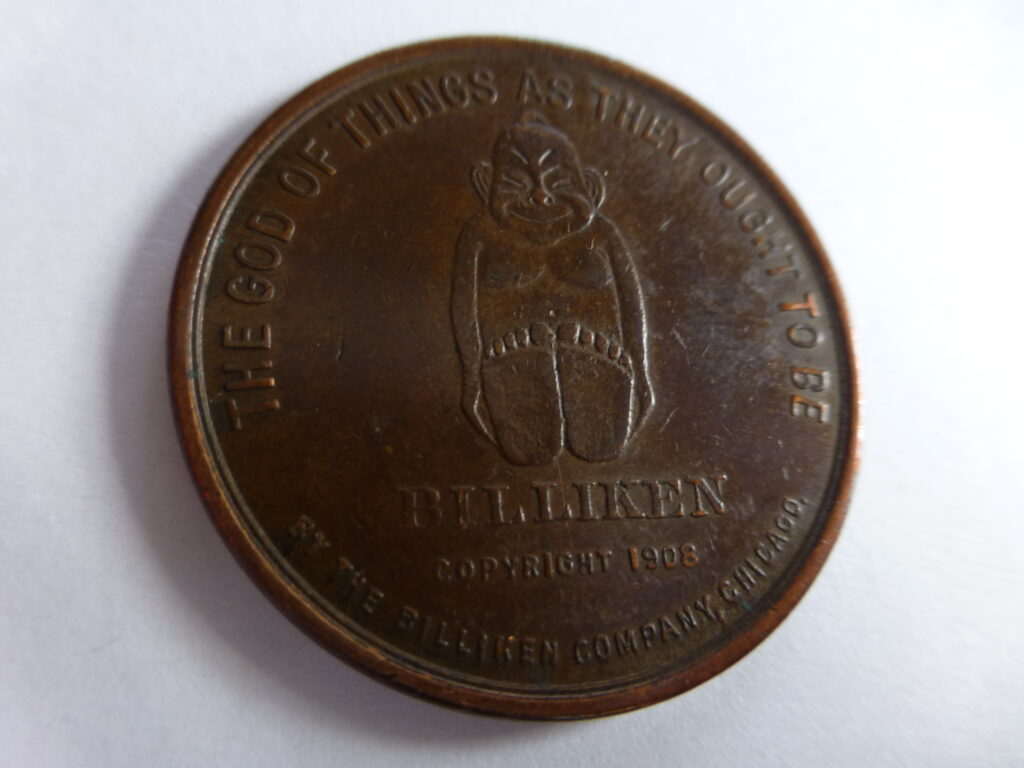Unique Examples of Lucky Tokens
Lucky Tokens and Coins
This page include some of the more interesting Lucky coins and tokens available for use at the Church of Good Luck. There are two main types of tokens. The first category are strictly Lucky tokens or hoodoo-type coins, likely sold by spiritual suppliers, candle shops, etc. The second category of coins consists of advertising tokens used to promote a business.
The first coin I will show you, however, is a very special coin that doesn’t fit either type. It is an example of a copper New Thought coin, probably from sometime around the turn of the last century:
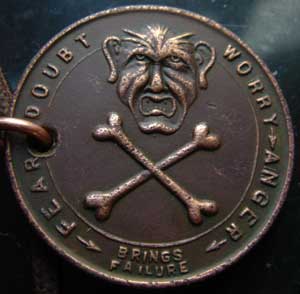
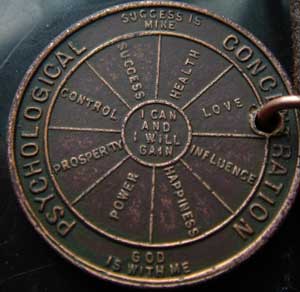
The obverse shows a long-eared demon and crossed bones with a legend indicating that Worry, Anger, Doubt and Fear Brings Failure. At the center of the reverse is the affirmation “I Can and I Will Gain” surrounded by eight blessings: Health, Love, Influence, Happiness, Power, Prosperity, Control and Success. Around the edge is the method “Psychological Concentration” and the motto “Success Is Mine – God Is With Me”. The coin has been holed for wearing, which it is – daily!
Hoodoo-Type Coins and Tokens
Lucky Mojo Good Luck Coins
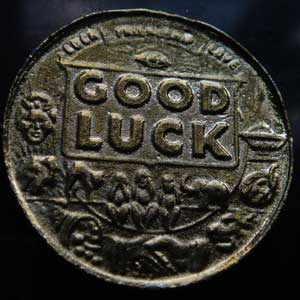

 Above is a Lucky Mo-Jo coin, purchased new in 2008. The design appears to be identical to a coin that appears in the 1944 King Curio Products catalog #81 on page 20 as seen here.
Above is a Lucky Mo-Jo coin, purchased new in 2008. The design appears to be identical to a coin that appears in the 1944 King Curio Products catalog #81 on page 20 as seen here.
There are 21 symbols on this coin: (obverse) 1. Cat’s Eye, 2. Burning incense, 3. John the Conqueror Root, 4. Tiger Head, 5. Clasped Hands, 6. Horn of Plenty, 7. Lodestone, 8. Mojo Head, 9. Elephant, 10. Three Wise Monkeys (reverse) 11. Burning Candle, 12. Rabbits Foot, 13. 4-Leaf Clover, 14. Key, 15. Heart and Arrow, 17. Number 7, 18. Star, 19. Horseshoe, 20. Horseshoe Nail, 21. Wishbone. In addition the obverse carries the words “Good Luck” as well as “Luck Friendship Love” and the reverse has a large Lucky Mo-Jo head with the slogan “Carry This Coin” and “Success Happiness”.
The metal appears to be aluminum. It is lightweight, similar to a Mardi Gras coin. The die used to strike this coin is very worn in the present day and the images are quite indistinct.
Below is a much older version of the coin – it was originally made in brass and as you can see the detail is much sharper:

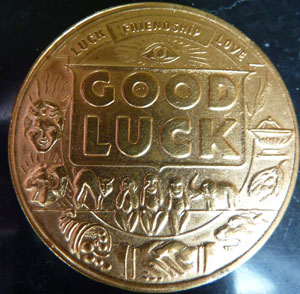
De Laurence Mascot Pocket Piece
This coin is a fine example of The De Laurence Mascot Pocket Piece. The accompanying instructions identify it as Order No. 711 and explains the symbols contained on each side which are related to each of the following topics: War! – Luck – Gambling – Love – Health – Enemies.
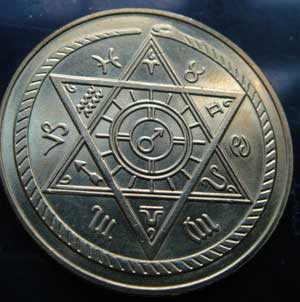

Egyptian-Style Good Luck Token
This is an Egyptian-style good luck coin, holed for wearing. The design elements, such as the yin-yang symbol, as well as the lack of older design elements such as the Billiken or swastika suggest a fairly recent design.
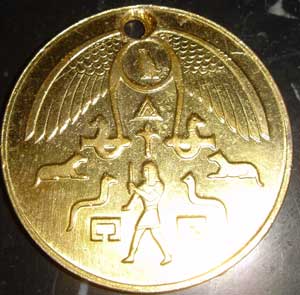
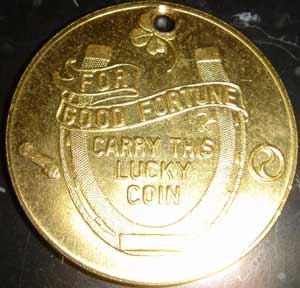
Rider Good Luck Coin
This is a beautiful bronze coin with that was designed by George F. Rider of Chicago. It was granted a Design Patent in 1928. The obverse shows a turbaned head being worshiped by two figures. The legend says “Listen To Me and Be Lucky” and “The Master Speaks”. The top legend at the edge says “Kill The Jinx”, a reference to the hoodoo term for bad luck. There is a symbol on both front and back that consists of a four-leaf clover with a swastika over it surrounded by a horseshoe entwined with a wishbone. Mr. Rider was also issued Design Patent #73010 for a ring design that features this device.
Among its many symbols this coin contains a Billiken. There is also a heart containing the number 14, evidently a reference to St. Valentine’s Day. Several of the images on this coin, such as the scarab and zodiac body are uncommon, while others, such as the bluebird of happiness, cat etc. are found on many similar coins of the period. This coin is advertised in this Soverign Curio catalog from the 1930s. If anyone knows the significance of the name “Jeffrey” on this coin, please notify us via the contact page.
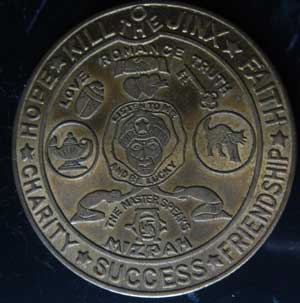

Shapiro Lucky Mojo Charm
This is another beautiful hoodoo-type coin that bears a patent number. This coin was designed by Morris Shapiro, one of the founders of Keystone Laboratories of Memphis TN, a leading manufacturer of hoodoo and spiritual supplies as well as cosmetics made for the African-American market. This coin was granted a Design Patent in 1934 The legend “Happiness Kills Hoodoo” accompanies images of a High John the Conqueror Root and a Magnetic Lodestone, two of the most important items in the hoodoo materia magica. The reverse pictures a master or Mahatma seated on an elephant throne with burning incense as well a several other lucky symbols. The use of the term “Lucky Mojo Charm” appears to be a direct attempt to compete with the King Novelty Lucky Mo-Jo Coin pictured above.
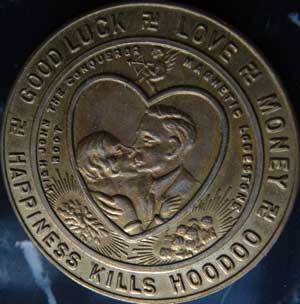
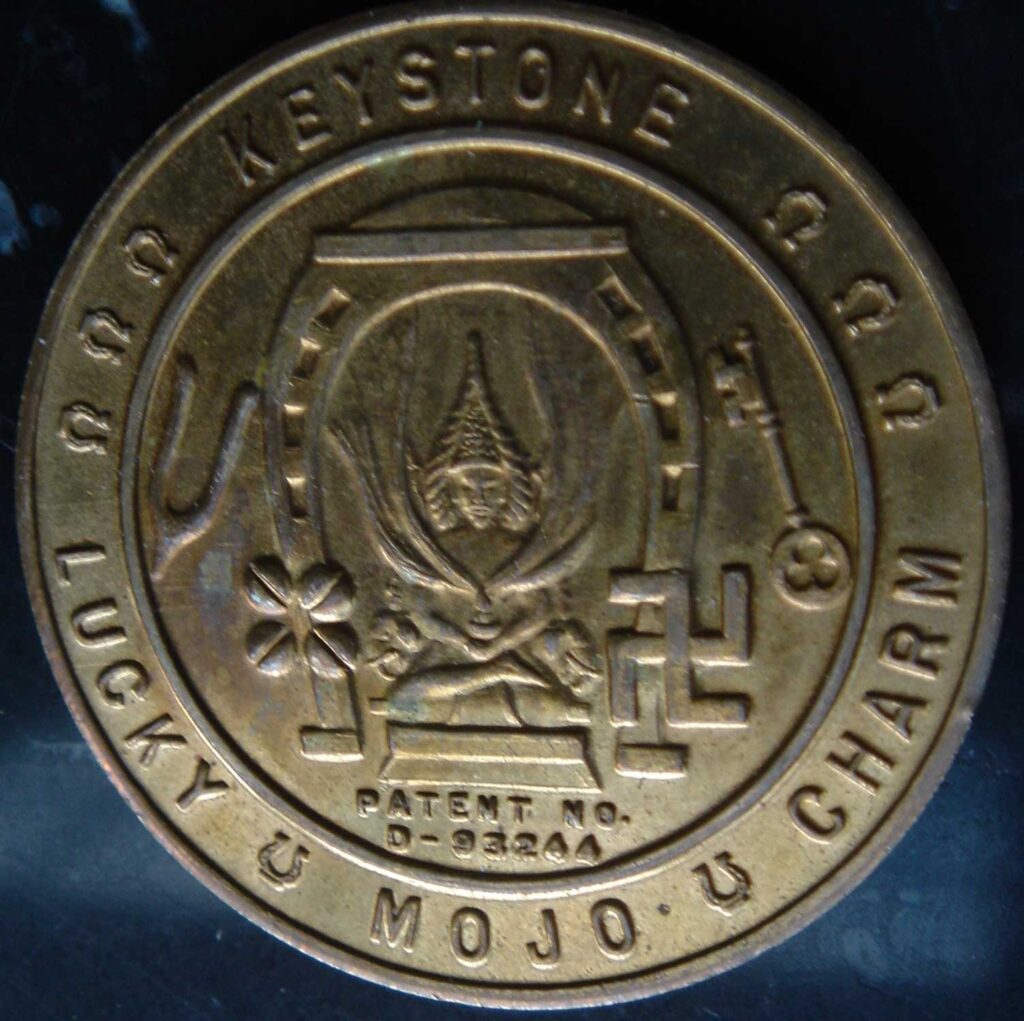
Easy Life Lucky Token (Possible Lucky Hand Co. Token)

 This coin pictures “The Lucky Hand” on the obverse along with bluebird, key, Aladdin lamp, nail and heart containing the number 14, presumably a symbol of St. Valentine’s Day. The reverse pictures a large horseshoe with a swastika, wishbone, four-leaf clover and rabbits foot. The unique motto at the bottom reads “Easy Life”. It is not known if this token is associated with The Lucky Hand Co. of Atlanta – a manufacturer of spiritual supplies.
This coin pictures “The Lucky Hand” on the obverse along with bluebird, key, Aladdin lamp, nail and heart containing the number 14, presumably a symbol of St. Valentine’s Day. The reverse pictures a large horseshoe with a swastika, wishbone, four-leaf clover and rabbits foot. The unique motto at the bottom reads “Easy Life”. It is not known if this token is associated with The Lucky Hand Co. of Atlanta – a manufacturer of spiritual supplies.
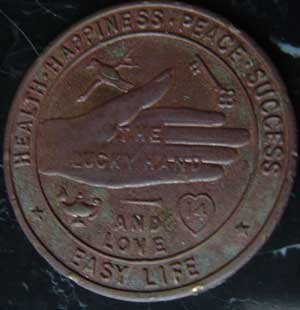
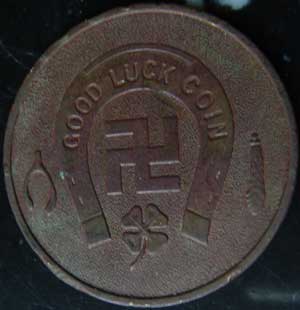
Lucky Breaks Token
This is “The Lucky Breaks Token”. The reverse contains a number of good luck symbols including a money bag and a Billiken. The presence of the Billiken suggests an early date for this token – likely the 1920s.
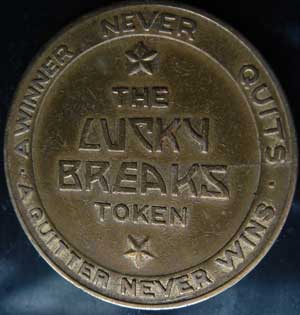

Four Leaf Clover Lucky Coin
This lucky coin gives additional information about two common lucky symbols. Each leaf of a four-leaf clover has a name – they are called Fame, Wealth, Love and Health. The lucky horseshoe is used “to keep luck within the house and keep out all evil”. Note that although the coin says “.999 Fine Silver” it is actually copper.
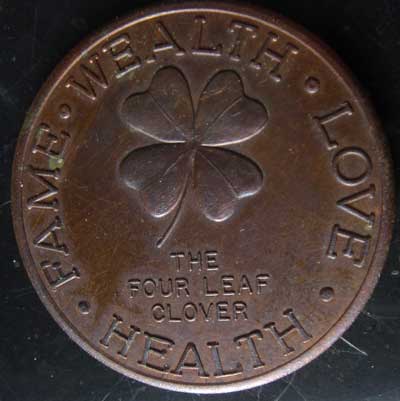
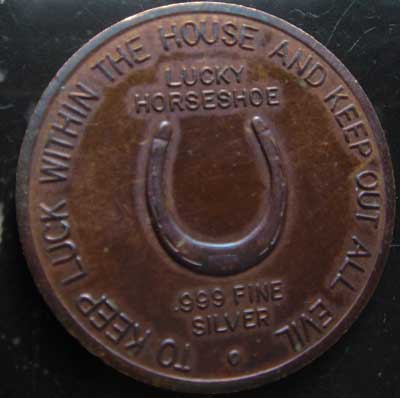
Good Luck Charm Curio
This beautiful coin is called the “Good Luck Charm Curio”. It depicts a handshake, a loving couple, a pile of money and an executive at his desk. The border reads: Success, Winner, Love, Position, Happiness, Friendship, Power, and Money. The “trunk-down” elephant suggests an early date for this design. The reverse is blank. Perhaps this design was intended to be used with advertising on the reverse.
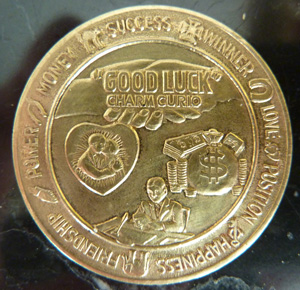
Swami Tokens
This coin is a classic design, often called a Swami token or coin, that has evidently been in production for decades. Some current versions substitute a star in place of the swastikas. The reverse pictures “The All Seeing Eye – Protects You From Evil”
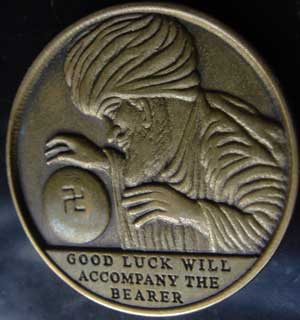

 This is another version of the Swami token that has a reverse similar to the previous token. This coin is smaller, being about the size of a US quarter – all prior coins are about half-dollar size. This particular example has a bale soldered on to facilitate hanging the token from a chain or cord.
This is another version of the Swami token that has a reverse similar to the previous token. This coin is smaller, being about the size of a US quarter – all prior coins are about half-dollar size. This particular example has a bale soldered on to facilitate hanging the token from a chain or cord.
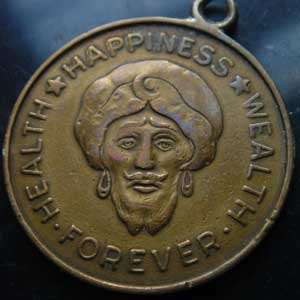
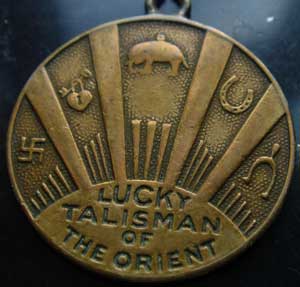
11 Keys to Power Token
Here is a token that was pictured on the cover of the book “11 Keys to Power”. It shows a huge seated God-like image in a pyramid being worshipped by throngs of followers. The reverse of the coin is pictured inside the book, in the chapter on Secret Talismans as being used for success in love
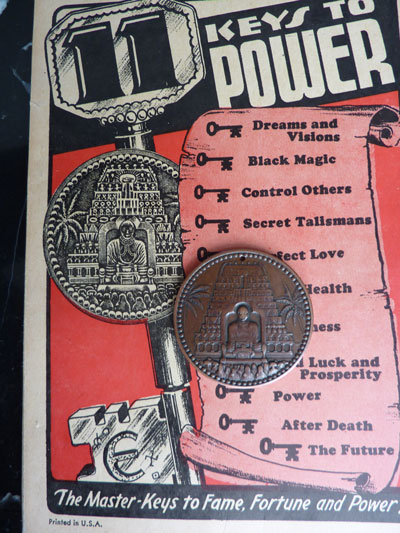
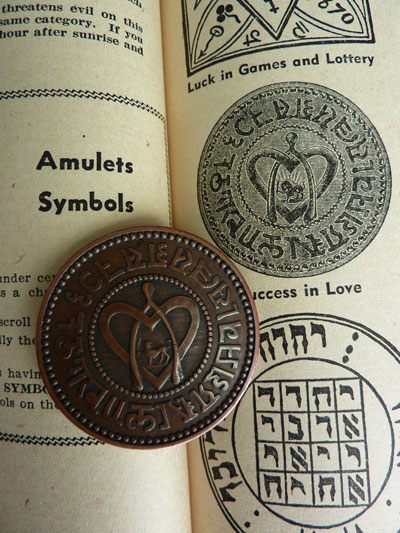
Sovereign Curio Lucky Coin
This coin is the Charm Curio that came free with every order from the Sovereign Products curio catalog!

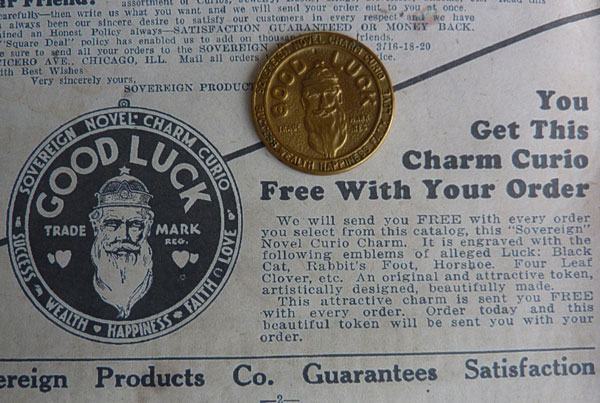
Master Good Luck Talisman
This token, another Swami-type coin, is called The Master Good Luck Talisman. This particular example is in rough shape, being worn, bent and possibly sampled for gold content. The obverse contains the $UCCE$$sigil used in hoodoo to draw money. A better example is shown in the following coin. The center of the reverse contains a key with the motto “The Magic Key of Truth” surrounded by lucky symbols including a Billiken.

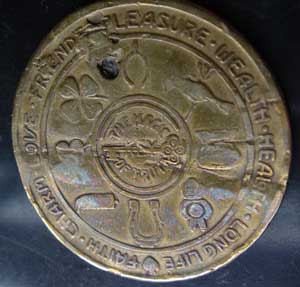
Here is another example of the Master Good Luck Talisman. It is a more recent version made of thin aluminum, rather than a copper alloy
Advertising Designs
Many businesses over the years have used good luck coins and tokens as a way to advertise. The idea was for customers to carry an advertising item with the business name and information and in exchange Good Luck was offered.
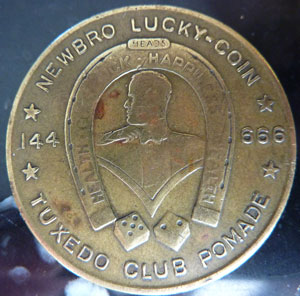
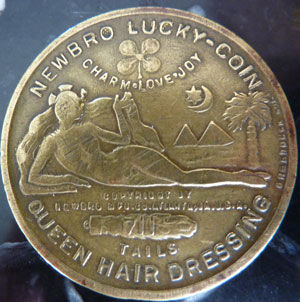
This example shows an obverse identical to the Master Good Luck Talisman above, only much more clearly. The turbaned Master has eyes that appear to be either open or closed and there are small rays emanating from them. It can be seen in this example that the Master is being worshiped by two acolytes burning incense and he is flanked by the images of a cat and a coiled snake. The design of the Master with acolytes and the legend Mizpah below is also very similar to the George F. Rider design above. This is an example of how hoodoo-type lucky coins were also sometimes adapted to advertising purposes.
This is an advertising coin from the Newbro Manufacturing Company of Atlanta, Georgia, makers of hair dressing products aimed at the African-American community. This coin was made by the Greenduck Company of Chicago, a maker of coins, medals and other metal specialties.
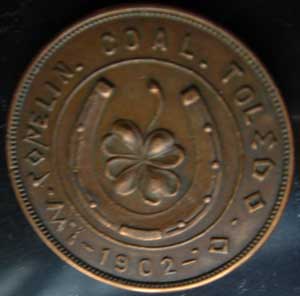
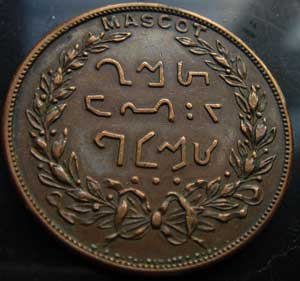
This wonderful coin dated 1902 advertises J. W. Copelin Coal Company of Toledo Ohio in a beautiful script. The reverse shows a Mascot – a symbol or writing that has not been identified as yet. Please contact the Church of you have any information on this image.


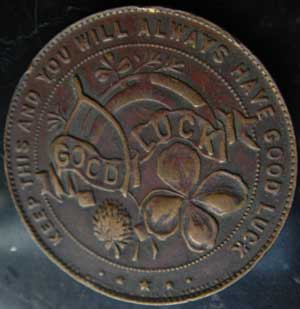
This artistic coin advertises Pelican Mutual, an old-time New Orleans area company. This also looks to be an early example of the type and explicitly sates “Keep This And You Will Always Have Good Luck”

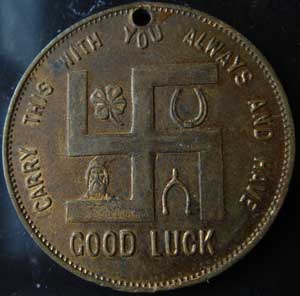
This obverse of this Labor coin invokes “8 Hours Work, 8 Hours Play, 8 Hours Sleep”. The reverse shows an commonly used device – a swastika with four different lucky symbols in each arm – this one containing a four-leaf clover, horseshoe, Master-like figure, and wishbone.
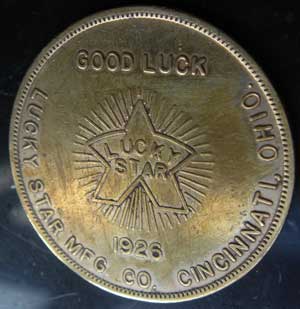
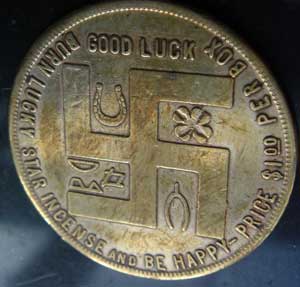
This Lucky Star Incense token contains a similar swastika device, but with apparently Egyptian symbols in place of the Master image. If you have additional information on these symbols please contact he Church.
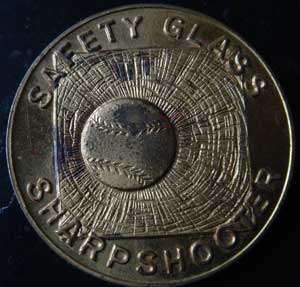

This coin was probably one of the many lucky tokens distributed at the 1934 Chicago Worlds Fair. It artistically show the effect of a baseball on a pane of glass as well as typical lucky symbols.

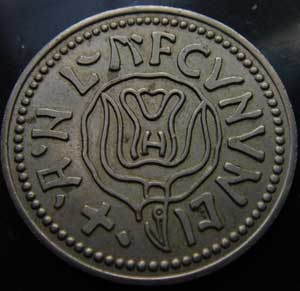
This advertising token for the Chicago lighter-fluid-flavored-liqueur Jeppson’s Mallort purports to be an authentic Viking Lucky Coin circa 1970s.

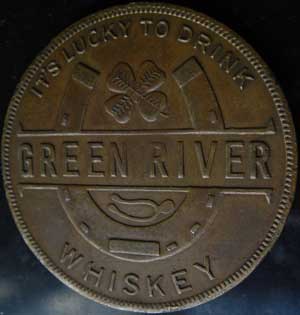
This is a relatively common token advertising Green River Whiskey – it was either produced in huge numbers or it has been reissued.

This coin, produced by the Victory Sparkler and Specialty Company of Baltimore, shows the Gobbo – a well dressed hunchback whose hump it is lucky to rub.
Here is a lucky coin from Sweden. It was supposedly minted at Avesta in the late 1700s making it the oldest token in the Museum:
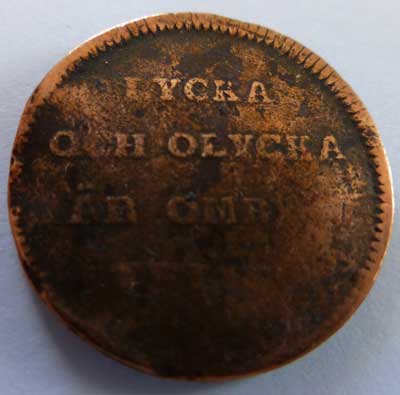
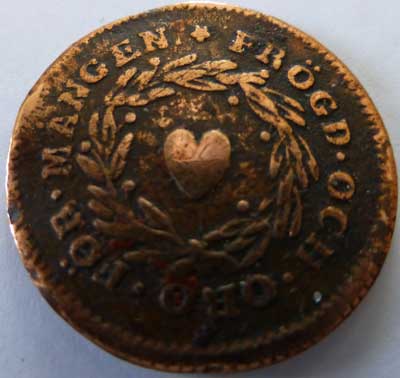
One side says “Luck and Unluck Are Fickle” and the other side says “Worry and Joy for Many”. Typical Scandinavian philosophy.
Place Souvenirs
Often cities, states, historic places, parks, etc. issued Good luck coins as souvenirs.

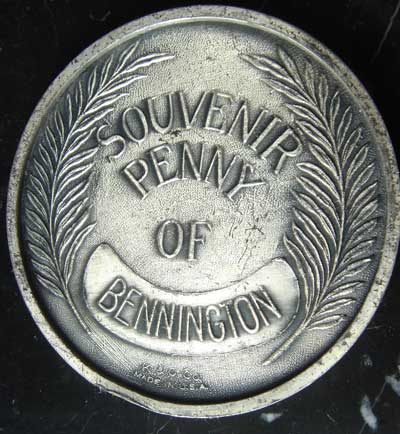
This is a huge souvenir penny of Bennington that displays the Three-No-Evil monkeys. This is an uncommon appeal to increase Good Luck, contentment and happiness by means of avoiding evil.
Here is an token from the US/Canadian border crossing at Grand Portage. The border at this point is the Pigeon River, which flows into Lake Superior.
Even the Turner Turnpike in Oklahoma gets a commemorative lucky token. From the depiction it appears to be a very straight roadway, with oil wells and bushes on either side, stretching into the distance. The Lake Superior Circle Route above seems a bit more scenic.
Encased pennies were often sold as lucky souvenirs. Here is one from the famous Stork Club of New York, and another from the St. Louis World’s Fair of 1904
Finally we have a classic good luck token featuring our favorite…BILLIKEN!
These tokens are often so badly worn the poem is no longer legible. Here is what it says:
I am the God of Luckiness, so always keep me nigh. Misfortune’s frown will disappear at one flash from my eye. Be sure that I am on the spot, when projects you begin. I am the God of Luckiness, my Name is Billiken.
